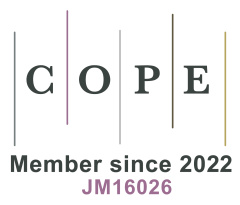Disinfection by-products pollution patterns and their cellular biomechanical effects
Abstract
This study integrates water quality monitoring data analysis with cellular biomechanics research to explore the relationship between disinfection by-products (DBPs) pollution patterns and their effects on cellular mechanical properties. Using data from 12 water treatment plants across three metropolitan areas in Eastern China, we identified four distinct DBPs pollution patterns: Chlorinated THMs dominated, HAAs dominated, Brominated DBPs enriched, and Emerging DBPs enriched. Multi-parametric biomechanical analysis utilizing atomic force microscopy, microfluidic deformation tests, and cytoskeletal structure evaluation revealed that all four patterns induced concentration-dependent alterations in cellular elasticity, deformability, and migration capacity. Pattern 4 (Emerging DBPs enriched) and Pattern 3 (Brominated DBPs enriched) exhibited the strongest effects, inducing significant biomechanical changes even at environmentally relevant concentrations. HK-2 kidney cells demonstrated the highest sensitivity among tested cell lines, consistent with epidemiological evidence linking long-term DBPs exposure to increased kidney cancer risk—an important public health concern. Canonical correlation analysis established systematic relationships between DBPs characteristics and specific biomechanical responses. These findings highlight potential mechanisms underlying DBPs-associated health risks and suggest that cellular biomechanical parameters could serve as sensitive early indicators of DBPs toxicity, potentially addressing a critical gap in current risk assessment approaches that rely primarily on high-dose cytotoxicity endpoints. The established pattern-specific relationships provide important insights for targeted water treatment strategies and monitoring approaches focusing on emerging unregulated DBPs.
References
1. Li XF, Mitch WA. Drinking Water Disinfection Byproducts (DBPs) and Human Health Effects: Multidisciplinary Challenges and Opportunities. Environmental Science & Technology. 2018; 52(4): 1681-1689. doi: 10.1021/acs.est.7b05440
2. Kalita I, Kamilaris A, Havinga P, et al. Assessing the Health Impact of Disinfection Byproducts in Drinking Water. ACS ES&T Water. 2024; 4(4): 1564-1578. doi: 10.1021/acsestwater.3c00664
3. Stalter D, O’Malley E, von Gunten U, et al. Mixture effects of drinking water disinfection by-products: implications for risk assessment. Environmental Science: Water Research & Technology. 2020; 6(9): 2341-2351. doi: 10.1039/c9ew00988d
4. Chen Y, Liang Q, Liang W, et al. Identification of Toxicity Forcing Agents from Individual Aliphatic and Aromatic Disinfection Byproducts Formed in Drinking Water: Implications and Limitations. Environmental Science & Technology. 2023; 57(3): 1366-1377. doi: 10.1021/acs.est.2c07629
5. Qiu T, Shi W, Chen J, et al. Haloketones: A class of unregulated priority DBPs with high contribution to drinking water cytotoxicity. Water Research. 2024; 259: 121866. doi: 10.1016/j.watres.2024.121866
6. Wei X, Yang M, Zhu Q, et al. Comparative Quantitative Toxicology and QSAR Modeling of the Haloacetonitriles: Forcing Agents of Water Disinfection Byproduct Toxicity. Environmental Science & Technology. 2020; 54(14): 8909-8918. doi: 10.1021/acs.est.0c02035
7. Zhang L, Qin J, Zhang Z, et al. Concentrations and potential health risks of methyl tertiary-butyl ether (MTBE) in air and drinking water from Nanning, South China. Science of The Total Environment. 2016; 541: 1348-1354. doi: 10.1016/j.scitotenv.2015.10.038
8. Wang W, Qian Y, Boyd JM, et al. Halobenzoquinones in Swimming Pool Waters and Their Formation from Personal Care Products. Environmental Science & Technology. 2013; 47(7): 3275-3282. doi: 10.1021/es304938x
9. Chen Z, Yang L, Li Z, et al. Application of biomarkers in the study of the health effects of disinfection by-products. Current Opinion in Environmental Science & Health. 2019; 7: 108-116. doi: 10.1016/j.coesh.2019.01.002
10. Yang L, Chen X, She Q, et al. Regulation, formation, exposure, and treatment of disinfection by-products (DBPs) in swimming pool waters: A critical review. Environment International. 2018; 121: 1039-1057. doi: 10.1016/j.envint.2018.10.024
11. Darling EM, Di Carlo D. High-Throughput Assessment of Cellular Mechanical Properties. Annual Review of Biomedical Engineering. 2015; 17(1): 35-62. doi: 10.1146/annurev-bioeng-071114-040545
12. Guo Q, Park S, Ma H. Microfluidic micropipette aspiration for measuring the deformability of single cells. Lab on a Chip. 2012; 12(15): 2687. doi: 10.1039/c2lc40205j
13. Mukherjee R, Saha M, Routray A, et al. Nanoscale Surface Characterization of Human Erythrocytes by Atomic Force Microscopy: A Critical Review. IEEE Transactions on NanoBioscience. 2015; 14(6): 625-633. doi: 10.1109/tnb.2015.2424674
14. Alcaraz J, Otero J, Jorba I, et al. Bidirectional mechanobiology between cells and their local extracellular matrix probed by atomic force microscopy. Seminars in Cell & Developmental Biology. 2018; 73: 71-81. doi: 10.1016/j.semcdb.2017.07.020
15. Tang G, Galluzzi M, Zhang B, et al. Biomechanical Heterogeneity of Living Cells: Comparison between Atomic Force Microscopy and Finite Element Simulation. Langmuir. 2018; 35(23): 7578-7587. doi: 10.1021/acs.langmuir.8b02211
16. Liu T, Zhang M, Wen D, et al. Temporal and spatial variations of disinfection by-products in South Taihu’s drinking water, Zhejiang Province, China. Journal of Water and Health. 2023; 21(10): 1503-1517. doi: 10.2166/wh.2023.149
17. Yu Y, Hossain MdM, Sikder R, et al. Exploring the potential of machine learning to understand the occurrence and health risks of haloacetic acids in a drinking water distribution system. Science of The Total Environment. 2024; 951: 175573. doi: 10.1016/j.scitotenv.2024.175573
18. Cortés-Eslava J, Gómez-Arroyo S, Risueño MC, et al. The effects of organophosphorus insecticides and heavy metals on DNA damage and programmed cell death in two plant models. Environmental Pollution. 2018; 240: 77-86. doi: 10.1016/j.envpol.2018.04.119
19. Mandal A, Giri S, Giri A. Assessment of toxicity, genotoxicity and oxidative stress in Fejervarya limnocharis exposed to tributyltin. Environmental Science and Pollution Research. 2024; 31(10): 14938-14948. doi: 10.1007/s11356-024-32220-5
20. Khani L, Martin L, Pułaski Ł. Cellular and physiological mechanisms of halogenated and organophosphorus flame retardant toxicity. Science of The Total Environment. 2023; 897: 165272. doi: 10.1016/j.scitotenv.2023.165272
21. Wang J, Liu T, Liu L, et al. Immune dysfunction induced by 2,6-dichloro-1,4-benzoquinone, an emerging water disinfection byproduct, due to the defects of host-microbiome interactions. Chemosphere. 2022; 294: 133777. doi: 10.1016/j.chemosphere.2022.133777
Copyright (c) 2025 Author(s)

This work is licensed under a Creative Commons Attribution 4.0 International License.
Copyright on all articles published in this journal is retained by the author(s), while the author(s) grant the publisher as the original publisher to publish the article.
Articles published in this journal are licensed under a Creative Commons Attribution 4.0 International, which means they can be shared, adapted and distributed provided that the original published version is cited.



 Submit a Paper
Submit a Paper
